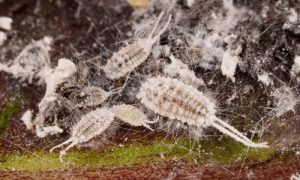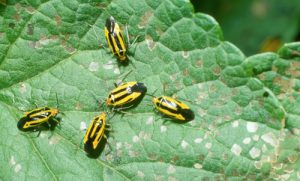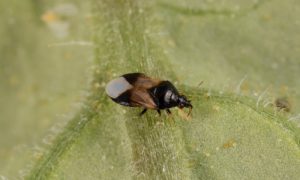Are you seeing fantastic creatures that are the stuff of nightmares (or an entomologists day dreams)? We all have had these moments and can often be surprised by how small some of these so called evil creatures are. We have compiled for you some of our newest articles on tiny insects (that may or may not be pests) so you can be ready for the close encounter you have.
We are proud to present you these newest Creatures from the University of Florida, Institute of Food and Agricultural Sciences (UF/IFAS) Featured Creatures Website. These articles were developed by UF scientists, students, and collaborators and the excerpts below are from the actual article. If you do not see anything new here visit the website and look around for information on a few Creatures to add to your list tiny insects you recognize.
Winter ant, false honey ant (suggested common names)
Authors: Jason L. Williams and Andrea Lucky, Entomology and Nematology Department, University of Florida
Available at: http://entnemdept.ufl.edu/creatures/misc/ants/Prenolepis_imparis.htm
Excerpt from the article: The winter ant, Prenolepis imparis (Say), is a widespread North American ant that is common across the United States. Sometimes called the false honey ant, this dominant woodland species is most active during cool weather, when most other ant species are less likely to forage (Figure 1). This species is one of the few native ants capable of tolerating competition with invasive species, and it persists in areas invaded by the Argentine ant, Linepithema humile. This species accomplishes this by foraging when many invasive species are inactive, and they are also aggressive toward other ants and produce abdominal secretions that are lethal to Linepithema humile. Prenolepis imparis is ecologically important as a seed disperser, and has been observed dispersing seeds of herbaceous plants in the southern Appalachian Mountains.
Figure 1. Profile view of Prenolepis imparis (Say) worker. Photograph from Williams and LaPolla (2016).
Striped mealybug
Authors: Ariane McCorquodale and Amanda Hodges, Entomology and Nematology Department, University of Florida
Available at: http://entnemdept.ufl.edu/creatures/orn/mealybug/Ferrisia_virgata.htm
Excerpt from the article: The striped mealybug, Ferrisia virgata Cockerell, is a small insect that is a pest of a broad range of plants (Figure 2). It has been unintentionally introduced across the globe through international trade. Mealybugs are sap-feeding insects that tap into the phloem via a piercing, straw-like mouthpart known as a stylet. Severe infestations of mealybugs can be fatal to a plant. Large populations of mealybugs appear as accumulations of white, cottony-looking wax on the plant. This wax is produced by special glands and gives the insects the “mealy” appearance from which the name “mealybug” is derived.
Figure 2. Adult and immature female Ferrisia virgata Cockerell on croton. Photograph by Ariane McCorquodale, University of Florida.
Fourlined plant bug
Authors: Matthew Borden and Adam Dale, Entomology and Nematology Department, University of Florida.
Available at: http://entnemdept.ufl.edu/creatures/veg/leaf/Poecilocapsus_lineatus.htm
Excerpt from the article: The fourlined plant bug (Figure 3), Poecilocapsus lineatus (Fabricius), is a common garden pest found throughout much of the United States and Canada east of the Rocky Mountains. It causes distinctive feeding damage on an enormous range of plants, but most often damages ornamentals in the mint (Lamiaceae) and composite (Asteraceae) families. Nymph and adult stages are active for a relatively short period during late spring and early summer. These insects overwinter as eggs deposited in tender stems of early-season plant growth. For unknown reasons it appears that populations naturally fluctuate, causing periodic outbreaks for one or several seasons.

Figure 3. Fourlined plant bug, Poecilocapsus lineatus (Fabricius), adults feeding, with associated damage. Photograph by Jeff Hahn, University of Minnesota Extension.
Insidious flower bug, minute pirate bug
Author: Danielle Sprague and Joe Funderburk, North Florida Research and Education Center, University of Florida
Available at: http://entnemdept.ufl.edu/creatures/beneficial/bugs/Orius_insidiosus.htm
Excerpt from the article: The insidious flower bug, Orius insidiosus Say, is a common predator of a wide variety of small, soft-bodied arthropods (Figure 4). Orius insidiosus is in the family Anthocoridae. Species of the genus Orius are commonly referred to as minute pirate bugs, while the common name for Orius insidiosus is the insidious flower bug (Funderburk 2009). Orius insidiosus is an important predator of many economically important pests (Lattin 1999, Funderburk et al. 2000, Silveira et al. 2004, Xu et al. 2006). In Florida, Orius insidiosus receives recognition for being the key predator of a major economic pest, the western flower thrips, Frankliniella occidentalis (Funderburk et al. 2000, Funderburk 2009).
Figure 4. The insidious flower bug, Orius insidiosus Say, feeding on a thrips larva. Photograph by Lyle J. Buss, University of Florida.
We hope you learned something new from reviewing the excerpts from these articles. If you would like to receive periodic updates when new Featured Creatures articles become available you can register for weekly updates from the UF/IFAS Pest Alert Blog or for monthly updates from the UF/IFAS Entomology and Nematology Department Newsletter.
 0
0


